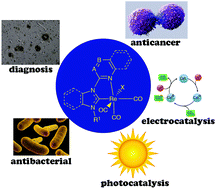Properties and prospects for rhenium(i) tricarbonyl N-heterocyclic carbene complexes
Abstract
Re(I) complexes bound to π-conjugated bidentate N-heterocyclic carbene ligands with formulation Re(CO)3(N^NHC)L (where N^NHC represents an imidazole or benzimidazole carbene ligand conjugated to a N-based heterocycle such as pyridine, pyrimidine, quinoline or quinoxaline) are a relatively new class of complexes belonging to the archetypal family of well known luminescent Re(CO)3(diim)X species (where diim is a conjugated diimine ligand and X is a halogen anion). The complexes Re(CO)3(N^NHC)L are characterised by blue-shifted emission compared to Re(CO)3(diim)X, but with shorter excited state lifetime decays and lower quantum yields, in contrast to trends expected by the energy gap law. Detailed investigations elucidated that these complexes are photochemically active and undergo ligand exchange reactions when excited to their lowest metal-to-ligand charge transfer excited states. This mechanism is entirely different from previously known mechanisms of photoactivated ligand substitution reactions in Re(I) tricarbonyl complexes. Therefore, the species Re(CO)3(N^NHC)L represent a new and unique class of photoactive Re(I) complexes. This feature article illustrates the research effort dedicated to the design and synthesis of Re(CO)3(N^NHC)L complexes and the elucidation of their photophysical and photochemical behaviour by means of a variety of spectroscopic techniques. Furthermore, for their unique characteristics, these new complexes have demonstrated potential value in several applications including catalysis, diagnosis and therapy. These studies will also be illustrated herein.



 Please wait while we load your content...
Please wait while we load your content...